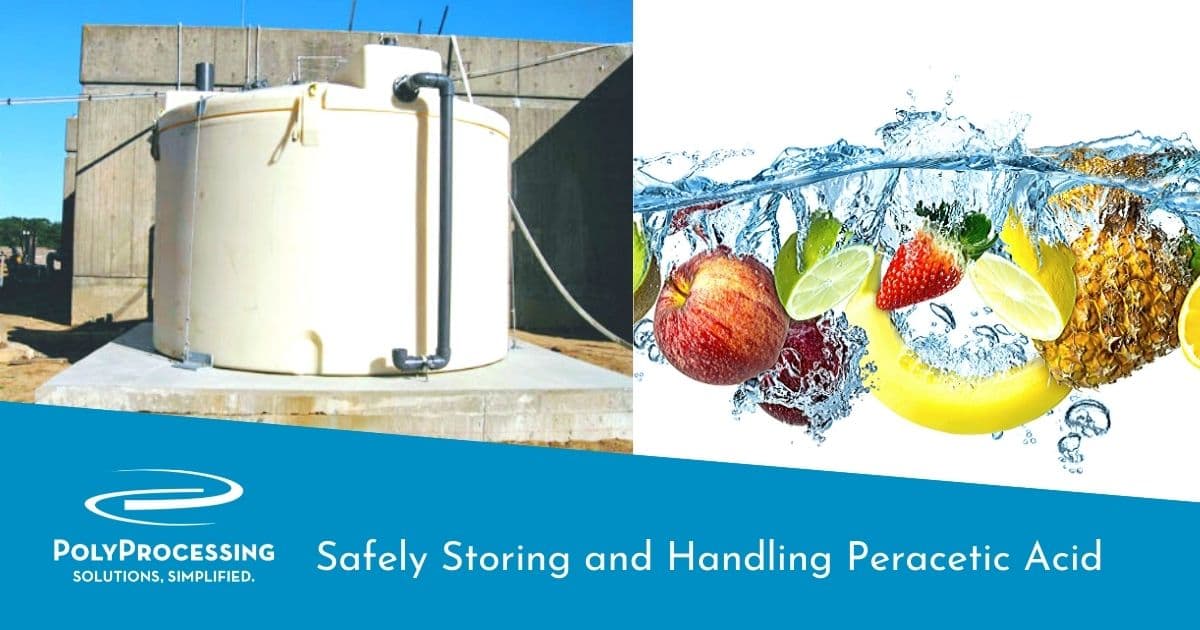Safely Storing and Handling Peracetic Acid
Peracetic acid is a bactericide and fungicide that is used in the food industry and water treatment industry. It’s a potent chemical that must be treated with care and stored properly. Improper handling could be costly and result in personal injury.

We've recorded a podcast with industry experts. We had an in-depth discussion about using and storing peracetic acid. You can listen to the full podcast and read the summary below.
You can also download the Poly Processing Tech Talk Podcast from several podcast players including iTunes, Google Play, Pandora, Stitcher, Spotify, and YouTube.
What Is PAA?
PAA is short for peracetic acid, sometimes called peroxy-acetic acid. PAA is a highly oxidizing biocide built on an organic acid.
PAA is essentially a new wave, super green bleach that contains zero chlorine. It is similar to sodium hypochlorite (or bleach), but while household bleach merely inhibits bacterial or mold growth, PAA cuts it like a knife. It donates oxygen to the cell wall or the spore and essentially destroys the organism on contact. This prevents the microbe from building up resistance, which means no organism can form a resistance to PAA.
Sodium Hypochlorite is a less powerful oxidizer and it tends to be a little less stable in storage.
How Is Peracetic Acid Used?
While bleach is a great fit for smaller uses and less routine tasks, peracetic acid is ideal for any company that needs to maintain food safety certifications. PAA is a no-rinse sanitizer and it has an abundance of label claims. It is incredibly versatile, and new markets emerge almost every month — including municipal wastewater, water treatment, hard surface sanitation, and fruit and vegetable processing.
There’s also a line of peracetic acid specially made to handle ready-to-eat foods. The food industry has widely adopted PAA as its intervention of choice, because most applications for food contact are no-rinse applications. If you're using high amounts of PAA for hard surface or for fruit and veggie wash, then you'll need to rinse any residual PAA. But even for wastewater, most applications won’t need neutralization.
How Should You Store PAA?
Peracetic acid has a much longer shelf life than bleach has — typically a year for most labels, although good storage conditions can extend it.
Peracetic acid is available in a range of concentrations, from 300 parts per million to 30 percent. In the food industry, most companies use up to a 25 percent concentration.
PAA can present some challenges with handling and application for engineers and plant personnel. The chemical concentration you use should depend on your application, how much volume there is, and how comfortable your personnel are with handling it. If you’re storing a large amount of PAA, a higher concentration can be more economical.
What Do the Ratio Numbers Mean?
You’ll see different labels on PAA, with two different numbers, such as 25-15. Those represent the ratio of hydrogen peroxide to acetic acid. The ratio will be heavier on peroxide for hard surface sanitation or for treating areas or materials that are a little bit tougher. For ready-to-eat foods, the ratio will be a higher acetic acid concentration and less hydrogen peroxide.
That’s important, because you don’t want to burn sensitive foods like chicken wingtips or apple skins. Most of your direct food contact formula will have less hydrogen peroxide. For applications such as municipal wastewater or hard surface sanitation, it’s better to have higher peroxide.
Do PAA products have an odor?

Peracetic acid has a powerful odor that smells like strong vinegar and gets in the back of your throat. Because of the odor, most facilities need scrubbers on their chemical storage tanks — especially with higher test and higher volume applications.
Many facilities look into options for vapor monitoring, as well. Depending on the need of your particular application, several methods are available, including handheld batch type testers, color emitters, test strips, and amperometric probes that give an electrical signal based on the oxidation potential in the water.
What Containers or Chemical Storage Tanks Are Best for PAA?
PAA is a very powerful oxidizer, second only to ozone and followed closely by chlorine dioxide. Oxidation has always been an issue when storing PAA, especially in the plant.
Because peracetic acid is an organic peroxide and comes with a secondary corrosive, it’s very reactive to a number of materials. When storing PAA, it’s important to carefully follow the safety data sheet. Refer to our chemical position statement compatibility chart or to Envirotech’s website for compatibility information.
Because PAA is such a strong oxidizer, customers choose cross-linked polyethylene engineered chemical storage tanks with the industry leading OR-1000 antioxidant system. Customers have relied on Poly Processing's cross-linked polyethylene tanks with the OR-1000™ System since the 1990's. The OR-1000 system gives you four times the antioxidant strength of any polyethylene on the market today.
Poly Processing also offers an Integrally Molded Flanged Outlet® (IMFO®) tank or Sloped Bottom IMFO® tank as a perfect fit for storing PAA. Integrally Molded Flanged Outlet fittings provide a full discharge eliminating residual chemicals or sediment from collecting in the bottom of the tank.
How Can I Learn More About Storing and Handling PAA?
Download Poly Processing’s chemical position statement with recommendations for storing peracetic acid safely or contact us at sales@polyprocessing.com or 800-523-9871 for more information.
- November 18, 2024
- Topics: Chemicals, Chemical Storage
About Poly Processing
Posts By Topic
Tech Talk Podcast Episodes
Subscribe By Email
Recent Posts
- Choosing Between Steel, Polyethylene, and Fiberglass Tanks: What You Need to Know
- Getting Your Plastic Tank Foundation Right: Why Professional Design Matters
- What to Expect in Lead Times for Chemical Storage Tanks: Planning Ahead
- The New 10,500-Gallon SAFE-Tank: Setting a New Standard for Chemical Storage Safety
- How Proper Mixing and Agitation Systems Prevent Chemical Separation in Storage Tanks
Tank Configurator

Find the recommended tank and system components for your chemical storage challenge.
Configure a Tank Package









